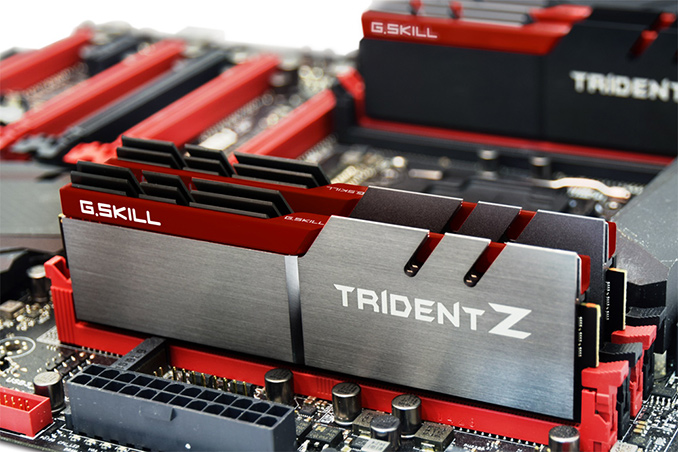G.Skill Reveals 2x8GB DDR4-4266 C19 and 4x16GB DDR4-3466 C14 Kits
by Anton Shilov on May 20, 2016 1:00 PM EST
Until recently enthusiasts who would like to use the fastest DDR4 memory with their Skylake-S processors had to use 4 GB DIMMs based on 4 Gb chips, typically sold in pairs for a 8 GB total memory. This week G.Skill has introduced three new sets of Trident Z memory modules that come with either an extremely high clock rate, or very aggressive timings.
The new G.Skill Trident Z memory modules based on Samsung’s 8 Gb DDR4 ICs and are available in 8 GB and 16 GB versions. The 8 GB DRAM sticks are rated to run at 3200 (CL13 13-13-33), 3466 (CL14 14-14-34) or 4266 (CL19 23-23-43) MT/s data rates, whereas 16 GB modules can work at 3200 and 3466 MT/s data rates at the aforementioned timings, with all kits running at the recommended DDR4 enthusiast setting of 1.35 volts. Like the rest of the Trident Z modules, the new sticks feature aluminum heat spreaders and custom black PCBs developed by G.Skill.
The new Trident Z modules are designed for Intel’s Skylake-S processors when used in Intel’s Z170-based motherboards which support XMP 2.0 technology (to automatically set their clock rates when they are installed into appropriate PCs). Using the 'performance index' metric from our memory reviews as a rough indication of general performance (rough in the sense that some workloads are frequency dependent, others are latency driven), the 3200 C13 modules come in at a PI of 246, the 3466 C14 modules have a PI of 248, and the 4299 C19 are at 225. Historically a higher frequency is harder to validate for reliability than a lower CAS Latency, and represents the main challenge when producing high-performance modules.
Because high-speed memory often needs to be validated with specific motherboards, so far G.Skill has validated its DDR4-4266 modules featuring 8 Gb chips on the ASUS ROG Maximus VIII Impact mainboard, but we expect that to expand over time. Meanwhile, the 8 GB and 16 GB DDR4-3200 and DDR4-3466 should work on many other motherboards as well. It is important to keep in mind that Intel’s HEDT platforms (Haswell-E) are more limited for extreme memory frequencies, which is why G.Skill officially has not validated the aforementioned modules on the Intel X99.
Exact prices of the new Trident Z memory modules from G.Skill are unknown, but do not expect them to be cheap: DDR4-4266 modules at this time have only been announced by a few companies, and we believe G.Skill is the first to offer 8 GB modules. Moreover, DDR4-3200 and DDR4-3466 modules with aggressive timings like CL13 or CL14 are also pretty rare.
Availability of memory modules with high clock rates will depend on the availability and binning of chips capable of operating at appropriate frequencies. Typically it is up to the memory companies to find which ICs are capable of these speeds, and companies compete in bidding for certain batches that have high hit rates for fast memory. Nonetheless, if the share of Samsung’s 8 Gb DDR4 chips that can operate in DDR4-4266 mode or with aggressive timings is significant, we may see competing solutions from other companies in the coming weeks or months.
Source: G.Skill


















17 Comments
View All Comments
ImSpartacus - Friday, May 20, 2016 - link
Oh man, better put these in my system to improve my video game fps.jabber - Sunday, May 22, 2016 - link
Yeah it will be amazing to go from 122FPS to 123FPS!aakash_sin - Monday, May 23, 2016 - link
+1damianrobertjones - Monday, May 23, 2016 - link
+1tps3443 - Monday, February 13, 2017 - link
Actually.. This memory makes a huge difference in gaming.Going from DDR4 3,000 to DDR4 4,000 provides on a average a 20%+ performance increase in FPS!
Your talking going from 60 fps to 73 fps.
I use to think the same way, fast memory is a waste of money..
After 4,000Mhz any faster doesn't help much!
But squeezing 22% more performance out of SLI 980TI's in game power on average, by bumping from DDR4 3000 to 4000?!
Sign me up!
Don't be ignorant. The results are real, and the bottleneck is there.
DDR4 4,000+ is very useful with i5 gaming systems. Especially with a GTX 1080 or just a very powerful GPU in general. It really helps to overclock the memory even further.
Running a i5 6609K @ 5,112 MHz and a GTX 1080 @ 2,250/11,800
Fallout 4 shows GPU utilization at only 60%. This means the GPU is bottlenecked, mind you Fallout 4 is very CPU hungry, and poorly optimized. Although, increasing the DDR4 to 4,200+ MHz from the standard DDR4 3000mhz. The GPU utilization went from , 60% to 87% .
The frame rates increased on average by 12-14 fps more. And 10 more on the minimum.
bloodinmyveins - Friday, May 20, 2016 - link
Soon they will replace my crappy crucials. Soon.yuhong - Friday, May 20, 2016 - link
I wonder if this is based on https://news.samsung.com/global/samsung-starts-mas...ltcommanderdata - Friday, May 20, 2016 - link
It would have been nice if they kept the lower DIMM height of the Ripjaws 4 (40 mm) instead of increasing it for the Trident Z (44 mm), but I suppose the larger heatsink may be what's helping to achieve the high clocks.WithoutWeakness - Monday, May 23, 2016 - link
I don't think the heatsinks are helping with maintaining the higher clock speed. These are still only running at 1.35V, which was the voltage used for low power DDR3. These would run absolutely fine without heatsinks. It may be possible to remove these heatsinks and fit Ripjaws 4 heatsinks to them but you're risking damaging the chips and voiding your warranty.Lolimaster - Friday, May 20, 2016 - link
I would take the 3200's with that 13cas latency. It's the sweet spot. you simply don't get the same performance/speed/latency/price ratio with the other options.